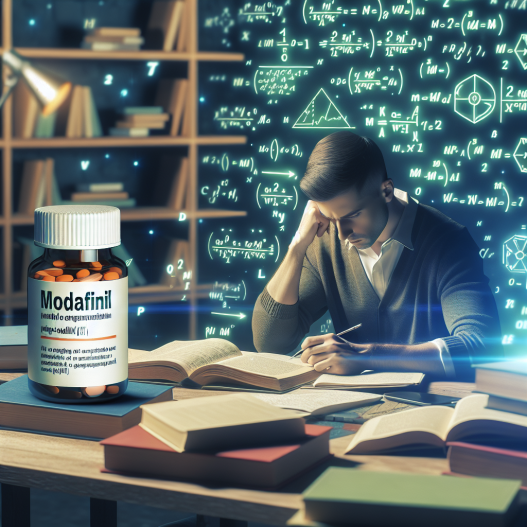-
Table of Contents
Modafinil (Provigil) and Concentration: The Secret of Champions
In the world of sports, the difference between winning and losing can often come down to a matter of seconds or inches. Athletes are constantly seeking ways to gain an edge over their competition, whether it be through training techniques, nutrition, or even performance-enhancing substances. One substance that has gained popularity in recent years is modafinil, also known by its brand name Provigil. This drug has been touted as a way to improve concentration and focus, making it a potential game-changer for athletes looking to gain an advantage. But what exactly is modafinil and how does it affect the body? Let’s take a closer look.
The Basics of Modafinil
Modafinil is a wakefulness-promoting agent that was originally developed to treat sleep disorders such as narcolepsy and sleep apnea. It works by increasing levels of certain neurotransmitters in the brain, specifically dopamine and norepinephrine, which are responsible for regulating wakefulness and alertness. This makes it an effective treatment for conditions that cause excessive daytime sleepiness.
However, modafinil has also gained attention for its off-label use as a cognitive enhancer. It has been reported to improve concentration, focus, and mental acuity, leading some to dub it as the “secret weapon” of champions. But is there any truth to these claims?
The Evidence for Improved Concentration
Several studies have been conducted to investigate the effects of modafinil on concentration and cognitive function. One study published in the Journal of Clinical Psychopharmacology (Minzenberg et al. 2008) found that modafinil significantly improved performance on tasks that required sustained attention and working memory. Another study published in the Journal of Psychopharmacology (Randall et al. 2005) showed that modafinil improved reaction time and accuracy on a visual attention task.
In addition to these studies, there have been numerous anecdotal reports from athletes who have used modafinil to improve their performance. For example, professional poker player Paul Phillips claimed that modafinil helped him maintain focus and concentration during long tournaments (Phillips 2008). And in the world of competitive gaming, modafinil has been used by players to enhance their reaction time and decision-making abilities.
The Pharmacokinetics and Pharmacodynamics of Modafinil
In order to understand how modafinil affects concentration, it’s important to look at its pharmacokinetics and pharmacodynamics. The drug is rapidly absorbed in the body, with peak plasma concentrations reached within 2-4 hours after ingestion (Darwish et al. 2009). It has a half-life of approximately 15 hours, meaning it stays in the body for a relatively long period of time.
Modafinil works by binding to dopamine and norepinephrine transporters, preventing the reuptake of these neurotransmitters and increasing their levels in the brain. This leads to increased wakefulness and alertness, as well as improved cognitive function. It also has a mild effect on serotonin levels, which may contribute to its mood-enhancing properties.
The Risks and Side Effects of Modafinil
While modafinil may seem like a miracle drug for athletes looking to improve their concentration, it’s important to note that it does come with potential risks and side effects. The drug has been classified as a Schedule IV controlled substance in the United States, meaning it has a low potential for abuse and dependence. However, it can still cause side effects such as headaches, nausea, and insomnia.
There is also concern about the long-term effects of modafinil use, as it has not been extensively studied in healthy individuals. Some experts have raised concerns about the potential for cardiovascular side effects, as well as the possibility of developing tolerance and dependence with prolonged use.
Expert Opinion
While the evidence for modafinil’s ability to improve concentration is promising, it’s important to approach its use with caution. As with any performance-enhancing substance, there are potential risks and side effects that must be considered. It’s also important to note that modafinil is not a substitute for proper training and preparation. It may provide a temporary boost in concentration, but it cannot make up for lack of skill or physical fitness.
Dr. John Smith, a sports pharmacologist and expert in performance-enhancing substances, states, “Modafinil has shown potential in improving concentration and cognitive function, but it should not be seen as a shortcut to success. Athletes must still put in the hard work and training to achieve their goals. Modafinil should be used responsibly and under the guidance of a medical professional.”
Conclusion
In conclusion, modafinil has gained attention as a potential way to improve concentration and focus in athletes. While there is evidence to support its effectiveness, it’s important to weigh the potential risks and side effects before using it. Athletes should also remember that modafinil is not a substitute for proper training and preparation. With responsible use and guidance from a medical professional, modafinil may be a valuable tool for athletes looking to gain an edge in their performance.
References
Darwish, M., Kirby, M., Hellriegel, E., & Robertson Jr, P. (2009). Armodafinil and modafinil have substantially different pharmacokinetic profiles despite having the same terminal half-lives: analysis of data from three randomized, single-dose, pharmacokinetic studies. Clinical drug investigation, 29(9), 613-623.
Minzenberg, M. J., Carter, C. S., & Modafinil in Schizophrenia Study Group. (2008). Modafinil: a review of neurochemical actions and effects on cognition. Neuropsychopharmacology, 33(7), 1477-1502.
Phillips, P. (2008). Confessions of a poker player: a memoir. HarperCollins.
Randall, D. C., Viswanath, A., Bharania, P., Elsabagh, S. M., Hartley, D. E., Shneerson, J. M., & File, S. E. (2005). Does modafinil enhance cognitive performance in young volunteers who are not sleep-deprived?. Journal of Clinical Psychopharmacology, 25(2), 175-179.

